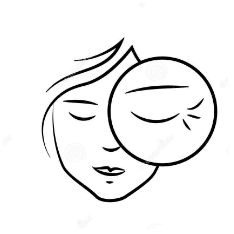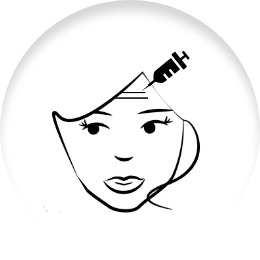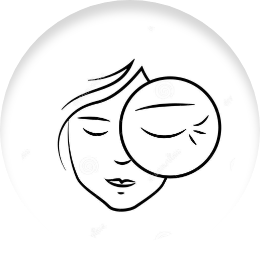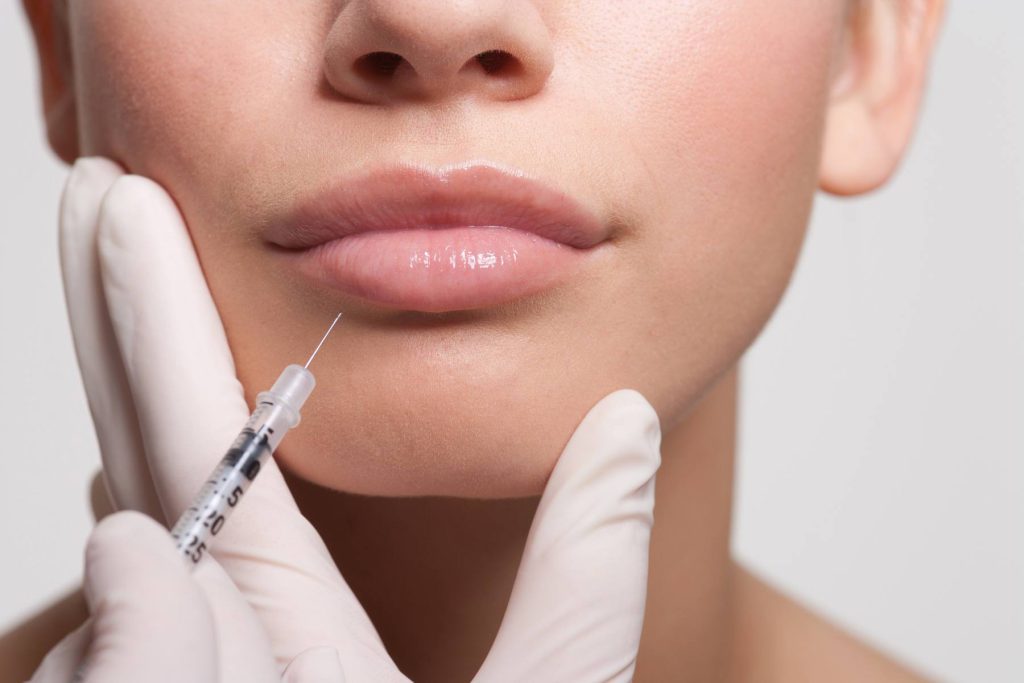Fillers
- Dermal Fillers are the most happening in the field of Aesthetics and Cosmetics now. They help you achieve, fuller, firm and younger looking face and add more volume to it.
- A youthful face is defined by its smooth contours, fullness, and plump and tight skin. Our skin loses its elasticity as we age, and collagen production slows down.
- It is a part of the aging process, but sometimes it’s very evident, and sometimes it’s early before we can believe we have aged.
- That’s when fillers come in. They are developed to improve the appearance of the face and its skin and give them a new, bold and confident look.
- It is the most sought-after treatment for aging and lacking fullness on the face, lips, and sometimes on the nose, which is liquid rhinoplasty.
- They come in all types and sizes. You should know which one is right and how to choose the suitable filler for your concern.
- It would be best if you had a specialist with immense knowledge and hands-on experience with fillers who set realistic expectations and gives you the best effective results possible.
- At Evoluer Aesthetics, we have maxillofacial, facial aesthetics, and board-certified plastic surgeons, who will treat you with the right, and best suitable treatment. Evoluer Aesthetics and plastic surgery have one of the best dermal filler treatments at an affordable price.it
What is dermal filler?
- Dermal fillers are injectable substances that can add volume and fullness to the skin. They commonly treat wrinkles, lines, and scars and add volume to the lips and cheeks. Dermal fillers are made from various substances, including hyaluronic acid, calcium hydroxylapatite, and poly-L-lactic acid.
- The procedure for administering dermal fillers is relatively simple and can be performed in a doctor’s office or clinic. The filler is injected into the skin using a fine needle, and the procedure typically takes only a few minutes to complete. Dermal fillers are generally well-tolerated and have few side effects, although mild swelling, redness, and bruising may occur at the injection site.
- Dermal fillers are a popular non-surgical option for enhancing facial features and improving the appearance of aging skin. They can provide immediate results and typically last for several months, although the duration of the effects varies depending on the type of filler used and the individual’s skin metabolism.
When to consider using a filler treatment?
Dermal fillers add volume, fullness, and contour to the face. They can be used to treat a variety of aesthetic concerns, including:

Wrinkles and fine lines
Dermal fillers can smooth out wrinkles and lines, particularly around the mouth, nose, and eyes.

Volume loss
As we age, we naturally lose volume on our face, which makes the skin sag and appears hollow. Dermal fillers can be used to restore volume and fullness to the face.

Scars
Dermal fillers are used to smooth out scars, particularly acne scars, and improve the skin's overall appearance.

Lips
Dermal fillers can add volume and definition to the lips. Your lips will look fuller and plumper.

Cheeks
Dermal fillers can enhance the cheeks' contour and shape, giving the face a more youthful appearance
How it works ?
- Dermal fillers work by adding volume and fullness to the skin. They are injected into the skin using a fine needle, and the procedure typically takes only a few minutes to complete.
- Poly-Llactic acid fillers are made from a synthetic polymer and work by stimulating collagen production in the skin. Dermal fillers are injected into the targeted skin area using a fine needle, and the filler is distributed evenly under the skin. The effects of these fillers are immediate, and they can last for several months, depending on the filler type used and the individual’s skin metabolism.
Where can fillers be used on the face?
Dermal fillers treat a variety of aesthetic concerns on the face, including:

Forehead
They smooth out wrinkles and lines on the forehead, adding volume and contour to the eyebrows.

Around the eyes
They help smooth out wrinkles and lines around the eyes and add volume to the tear troughs (the area under the eyes that can appear sunken or hollow).

Nose
They will smooth out bumps or irregularities on the nose and straighten a crooked or bent nose.

Cheeks
They help in enhancing the cheeks' contour and shape, giving the face a more youthful appearance.

Mouth
Dermal fillers can smooth out wrinkles and lines around the mouth and add volume to the lips.


Jawline
They help redefine and contour the jawline, creating a more chiseled and defined appearance.


Neck
Dermal fillers can add volume and smooth out wrinkles and lines on the neck.



Lips
Dermal fillers can be used on lips to enhance the shape of the lip and the volume. This also helps in hydrating the hypertonic lips after aging
Types of Fillers
- Choosing a qualified and experienced healthcare provider to administer dermal fillers is vital to ensure the best possible results. They will recommend the best filler for your specific needs and goals, and they will set the expectations right.
- Hyaluronic acid fillers are made from a naturally occurring substance called hyaluronic acid, found in the skin. They add volume and hydration to the skin, treat wrinkles and lines, and add volume to the lips and cheeks.
- Examples of hyaluronic acid fillers include Juvederm, and Belotero.
- These fillers are made from a synthetic form of calcium in the body. They add volume and fullness to the skin, treat wrinkles and lines, and enhance the cheeks’ contour and shape.
- Examples of calcium hydroxylapatite fillers include Radiesse and Sculptra.
- Poly-L-lactic acid fillers are made from a synthetic polymer called poly-L-lactic acid. They add volume and stimulate collagen production in the skin, which can help smooth out wrinkles and lines. These fillers are often used to treat facial volume loss and are particularly useful for treating deeper wrinkles and lines.
- An example of a poly-L-lactic acid filler is Sculptra.
- These fillers are made from fat taken from different parts of the patient’s body and injected into the treatment area.
- They are used to add volume and fullness to the skin and are often used to treat facial volume loss and enhance the contour and shape of the face.
- Polymethylmethacrylate (PMMA) fillers are made from a synthetic polymer called PMMA. They add volume and fullness to the skin, treat wrinkles and lines, and enhance the contour and shape of the face.
- An example of a PMMA filler is Bellafill.
Choosing a suitable filler
- Choosing a qualified and experienced cosmetic surgeon to administer dermal fillers is important to ensure the best possible results. Your surgeon will be able to discuss the different types of fillers available and recommend the best one for your specific needs and goals.
Different dermal fillers are used to treat different aesthetic concerns, so choosing a filler tailored to your needs and goals is crucial. For example, a hyaluronic acid filler such as Juvederm may be a good choice if you are concerned about wrinkles and lines around the mouth. To add volume to the cheeks or enhance the contour of the face, a calcium hydroxylapatite filler such as Radiesse may be a better option.
Different dermal fillers are used in different parts of the face, so it is essential to choose a filler that is suitable for the location of the treatment. For example, hyaluronic acid fillers are often used to treat wrinkles and lines around the mouth, while calcium hydroxylapatite fillers are often used to enhance the contour and shape of the cheeks.
Different dermal fillers have different longevity, so it is vital to choose a filler that will provide the desired results for the desired length of time. Hyaluronic acid fillers typically last for several months, while calcium hydroxylapatite fillers and poly-L-lactic acid fillers may last up to two years or more.
Different dermal fillers carry different risks and possible side effects, so choosing a filler with a low risk of complications is essential. Hyaluronic acid fillers and calcium hydroxylapatite fillers are generally well-tolerated. They have few side effects, while poly-L-lactic acid fillers and autologous fat fillers may carry a higher risk of complications.
How to choose a clinic and doctor for a dermal filler procedure?
There are several important factors to consider while choosing a clinic or doctor for dermal filler treatment, including:
Safety:
Safety should be a top priority when choosing a clinic or doctor for dermal filler treatment. Look for a provider who follows strict safety protocols and uses sterile equipment.
Qualifications and experience:
It is important to choose a clinic and a doctor who is qualified and experienced in administering dermal fillers. Look for a provider who has completed a medical degree and has specialized training in injectable treatments.
Recognised clinic:
Look for a clinic or doctor who has a good reputation and is well-respected in the medical community. Always ask friends, family, and other healthcare providers for recommendations, or you can check online reviews and ratings. Go for a consultation, ask the questions necessary and decide on the right doctor and the clinic.
Comfort level:
Feeling comfortable and confident in your chosen clinic and doctor is essential. Feel free to ask questions and express any concerns about the procedure.
Cost of Dermal filler treatments:
Types of dermal fillers and usage vary depending on the treatment area and concern it addresses. So enquiring and comparing prices is essential. Remember that the cheapest option may only sometimes be the best choice, but always ensure that you are receiving high-quality care from a qualified doctor and clinic.
Certification:
Make sure that the clinic and doctor are board certified by medical organizations, and also check for reviews and before/after images.
Dermal Fillers Treatment process:
There are several important factors to consider while choosing a clinic or doctor for dermal filler treatment, including:


Consultation:
Before starting treatment, you will meet with a cosmetic surgeon or a qualified doctor to discuss your aesthetic goals and concerns. The provider will evaluate your skin and facial structure to determine the appropriate treatment plan.


Preparation:
Certain topical applications and creams will be suggested after the procedure for better skin health per individual requirements and medications if required.


Injection:
The doctor will use a fine needle or cannula (a thin, flexible tube) to inject the dermal filler into the desired area. The injection process may take 15-30 minutes, depending on the filler used and the treatment area's size.


Recovery:
Feeling comfortable and confident in your chosen clinic and doctor is essential. Feel free to ask questions and express any concerns about the procedure.


Post-treatment:
Certain topical applications and creams will be suggested after the procedure for better skin health per individual requirements and medications if required.


Follow-up:
It is essential to follow the provider's post-treatment instructions and attend any follow-up appointments as recommended. The doctor may recommend follow-up treatments to maintain the results of the dermal filler.
Post Treatment Instructions:
Here are some general post-treatment instructions to follow after receiving dermal fillers:
- Avoid strenuous activity: It is recommended to avoid strenuous activity, such as exercise, for at least 24 hours after treatment to minimize the risk of swelling and bruising.
- Avoid the heat: Avoid exposure to heat, such as hot showers, saunas, and hot baths, for at least 24 hours after treatment.
- Avoid massaging the injection site: Do not rub, massage, or manipulate the injection site, which may cause the filler to migrate to an undesired location.
- Avoid makeup: Avoid applying makeup to the injection site for at least 24 hours after treatment.
- Avoid alcohol: Avoid consuming alcohol for at least 24 hours after treatment, as it may increase the risk of swelling and bruising.
- Avoid blood-thinning medications: Avoid taking blood-thinning medications, such as aspirin, for at least a week before and after treatment, as they may increase the risk of bleeding and bruising.
- Use ice: You may use ice to reduce swelling and discomfort at the injection site. Apply ice for 15-20 minutes at a time, several times a day, for the first 24-48 hours after treatment.
- It is essential to follow your doctor’s specific post-treatment instructions. Ask your doctor for any questions or concerns about the treatment or recovery.
- Dermal fillers are generally safe and effective when used by experienced doctors. However, like any medical treatment, there are some potential risks and side effects associated with dermal fillers
- These may include:
- Swelling and bruising: Swelling and bruising at the injection site are common side effects of dermal fillers. These side effects usually resolve within a few days.
- Infection: There is a small risk of infection at the injection site. To reduce the risk of infection, follow post-treatment instructions for the injection site.
- Allergic reactions: There is a risk of allergic reactions to the filler material. Your doctor will ask about your medical history and perform a patch test to check for allergies before treatment.
- Imperfections: In rare cases, dermal fillers may cause uneven or lumpy results. This can be corrected with additional treatment.
- Nerve damage: In rare cases, dermal fillers may cause nerve damage, resulting in temporary or permanent numbness or muscle weakness.
- Always ask your doubts and get your medical history correct. Choosing a reputable and experienced clinic is also vital to minimize the risk of complications.
- A liquid facelift is a non-surgical facial rejuvenation procedure that uses injectable substances, such as dermal fillers and other injectables to relax wrinkles, to lift and tighten the skin, smooth out wrinkles and lines, and restore volume to the face.
- The procedure is designed to provide a more youthful and refreshed appearance without the need for surgery.
- During a liquid facelift, fillers are injected into specific areas of the face to target particular concerns, such as sagging skin, deep wrinkles, and volume loss.
- The procedure typically takes 30-60 minutes and can be performed in a provider’s office. Liquid facelifts are generally less invasive and have shorter recovery times than surgical ones. However, the results of a liquid facelift are not as long-lasting as those of a surgical facelift.
- The effects of dermal fillers typically last for several months to a year, while the effects of other injectables usually last for 3-4 months.
- It is essential to discuss your aesthetic goals and any potential risks and side effects with your doctor before starting a liquid facelift treatment.
Advances in dermal fillers:


- Dermal fillers have come a long way in recent years, with new products and techniques constantly being developed to improve their effectiveness and safety. Some of the advances in dermal fillers include:
- Some newer dermal fillers are designed to last longer than traditional fillers, typically lasting several months to a year. These longer-lasting fillers are made with hyaluronic acid or poly-L-lactic acid, which are absorbed more slowly by the body.
Many newer dermal fillers are designed to provide a more natural-looking result using smaller, smoother particles that blend seamlessly with the skin.
Many newer dermal fillers have been developed with improved safety profiles and are less likely to cause side effects such as swelling, bruising, or allergic reactions.
- Some recent dermal fillers can be used to treat previously unsuitable areas, such as the neck and décolletage.
Some newer dermal fillers are designed to be combined with other therapies, such as lasers or skin tightening procedures, to enhance their effectiveness and provide more comprehensive facial rejuvenation.
No, liquid rhinoplasty and nose fillers are not the same things.
Liquid rhinoplasty, also known as non-surgical rhinoplasty, is a cosmetic procedure that uses injectable fillers to alter the shape of the nose without the need for surgery.
It can be used to add volume, smooth out bumps or indentations, and correct minor asymmetries. This procedure is typically done in a doctor’s office and requires little to no downtime.
Nose fillers, on the other hand, are injectable fillers specifically used to add volume to the nose. They are often used in combination with other techniques, such as liquid rhinoplasty, to achieve the desired shape and appearance of the nose.
Nose fillers can be made from various materials, such as hyaluronic acid, calcium hydroxylapatite, and poly-L-lactic acid.
Liquid rhinoplasty is a complete procedure that can address a range of cosmetic concerns, while nose fillers are specifically used to add volume to the nose.
It’s essential to consult with a qualified medical professional to determine the best approach for your specific needs and goals.
Filler reversal is a procedure used to remove or dissolve injectable fillers to add volume or improve the appearance of the skin. Injectable fillers, such as hyaluronic acid, calcium hydroxylapatite, and poly-L-lactic acid, are commonly used in cosmetic procedures to add volume to the face, smooth out wrinkles and lines, and enhance the contours of the face.
There are several reasons why someone might want to have filler reversal, including:
➖Unsatisfactory results: If the person is not satisfied with how the fillers have changed the appearance of their face, they may choose to have them removed or dissolved.
➖Allergic reactions: In rare cases, people may develop an allergic reaction to the filler material. In these cases, the filler may need to be removed to alleviate the symptoms.
➖Complications: Injectable fillers can sometimes cause complications, such as lumps, bumps, or infections. If these complications occur, the filler may need to be removed or dissolved to resolve the issue.
There are several ways to reverse the effects of injectable fillers, including using an enzyme to dissolve the filler, injecting a substance to break down the filler, or surgically removing the filler.
It’s important to consult with a qualified medical professional to determine the best approach for your specific situation.
Lip Fillers:
- Here are some key things to consider when considering lip fillers:
- Lip fillers are injectable substances that add volume and shape to the lips. They are typically made from hyaluronic acid, a naturally occurring substance that helps to add volume and hydration to the skin.
- Lip fillers are administered by a medical professional, such as a dermatologist or plastic surgeon. The procedure is usually done in a doctor’s office and takes 30 minutes to an hour to complete.
- Lip fillers can add volume to thin or aging lips, smooth out wrinkles and lines around the mouth, and enhance the overall shape and contours of the lips.
- Lip fillers are generally safe when administered by a qualified medical professional. However, like any medical procedure, there are potential risks and complications, such as swelling, bruising, and infection. Be informed before the procedure of all the risks and side effects.
- The duration of lip fillers can vary depending on the type of filler used and the individual’s metabolism. In general, hyaluronic acid fillers last about six to nine months, while poly-L-lactic acid fillers can last up to two years.


Advances in lip fillers:


- Lip fillers, also known as dermal fillers or injectable lip augmentation, are cosmetic procedures used to add volume and shape to the lips. Over the years, there have been several advances in the materials and techniques used for lip fillers, including.
- Injectable fillers for the lips are made from hyaluronic acid, a naturally occurring substance that helps to add volume and hydration to the skin. Newer forms of hyaluronic acid, such as Vycross and STYLAGE, have been developed that offer improved longevity and natural-looking results.
Injectors now use new methods, “thread lift” or “lip flip,” to create a more natural-looking result. The thread lift involves injecting tiny threads into the lips, which lift and smooth the skin, while the lip flip involves injecting small amounts of filler into the Cupid’s bow and corners of the mouth to create a plumping effect.
- Non-surgical lip augmentation procedures, such as laser lip treatments or plasma treatments, have become more popular in recent years. These treatments use heat or energy to stimulate collagen production and enhance the volume and shape of the lips without the need for injections.
- Overall, the advancements in materials and techniques have helped to make lip fillers a safe and effective option for adding volume and shape to the lips.
FAQ
The cost of dermal fillers can vary depending on several factors, including the type of filler used, the location of the treatment, and the extent of the treatment.
In general, dermal fillers can range in cost from 15,000rs to 30,000 rs per treatment.
It also depends on the amount of the fillers used in ml, for example, 2ml,3ml,4ml, etc.
Hyaluronic acid fillers, such as Juvederm are commonly used dermal fillers and tend to be on the lower end of the price range.
Calcium hydroxylapatite fillers, such as Radiesse, and poly-L-lactic acid fillers, such as Sculptra, tend to be more expensive.
It’s important to note that dermal fillers are cosmetic procedures and are not covered by insurance.
It’s recommended to compare prices from different providers to find the best option for your budget.
It’s also important to choose a qualified and experienced medical professional to ensure the best possible results and minimize the risk of complications.
- The results of a filler treatment are typically immediate, and you should see improvement immediately after the procedure. However, you may experience swelling, bruising, or redness in the treated area for a few days after the procedure. These side effects are temporary and will resolve on their own.
- It’s also worth noting that the final results of a filler treatment may not be fully apparent for a few weeks. This is because the filler takes time to integrate into the skin thoroughly and because swelling may obscure the final result. Once the swelling has subsided and the filler has fully integrated into the skin, you should see the treatment’s final effect.
- If you have any concerns about the results of your filler treatment, it’s important to discuss them with your medical professional. They can assess your situation and advise you on any necessary follow-up treatment.
- During a liquid facelift, fillers are injected into specific areas of the face to target particular concerns, such as sagging skin, deep wrinkles, and volume loss. The procedure typically takes 30-60 minutes and can be performed in a provider’s office.
- Liquid facelifts are generally less invasive and have shorter recovery times than surgical ones. However, the results of a liquid facelift are not as long-lasting as those of a surgical facelift. The effects of dermal fillers typically last for several months to a year, while the effects of other injectable like wrinkle relaxers usually last for 3-4 months.
- It is essential to discuss your aesthetic goals and any potential risks and side effects with your doctor before starting a liquid facelift treatment.
- The number of sessions required to achieve the desired results varies depending on the type of filler used, the area of the face being treated, and the individual’s skin and age.
- Typically, dermal fillers are administered in a series of treatments. The number of treatments required will depend on the individual’s specific goals and the extent of the treatment area. Some people may see their desired results after one treatment, while others may require multiple treatments to achieve their desired outcome.
- It’s best to discuss your goals and desired results with your doctor to recommend a treatment plan tailored to your needs. They can provide you with more information about the number of sessions required to achieve your desired results.
- The duration of the effects of dermal fillers is affected by several other factors, including the individual’s skin type, age, and lifestyle. Some people may find that the effect of their dermal fillers lasts longer than others.
- It’s important to remember that dermal fillers are not a permanent solution, and the results are temporary. The effects of the treatment will gradually fade over time, and touch-up treatments may be needed to maintain the desired results.
- Always know about the filler type used by your doctor. Understand the risks and side effects. Follow the post-care instructions thoroughly. Wait for results to appear based on your skin age and metabolism. Follow up with the doctor if necessary.
